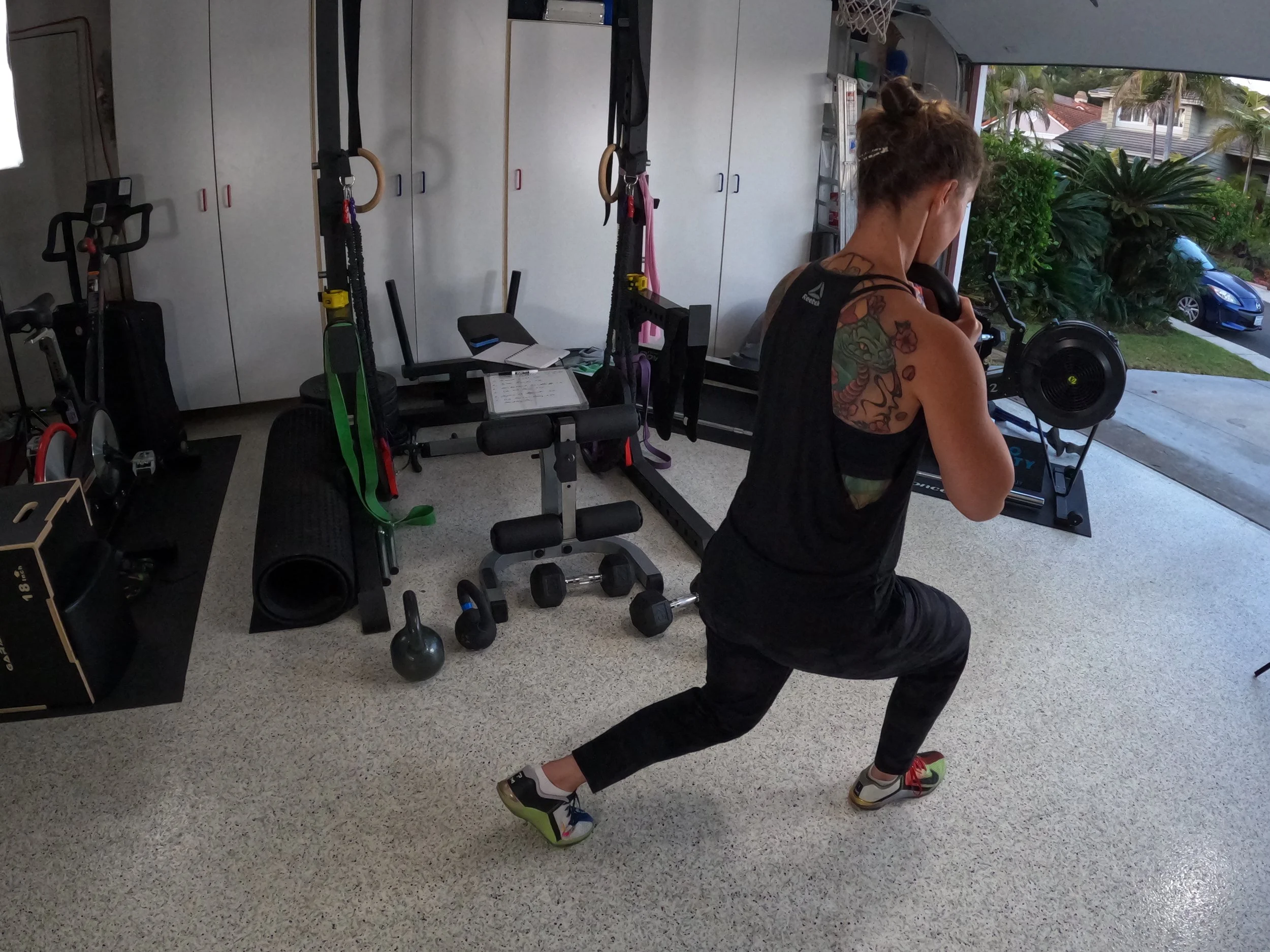
Chronic Pain Progressions (CPP)
Frustrated or unsure about how in the world to exercise with chronic pain? End up with intolerable blowback, crashes, and frequent or unpredictable flares every time you work out that just makes you want to give up? I get it. I’ve been there, and I can help.
I created Chronic Pain Progressions (CPP) because too many of us feel like flares are inevitable with movement and it always leads to more pain, leaving us feeling like exercise is impossible and that losing those parts of ourselves is unavoidable.
But it does not have to be that way. There are so many things we actually can impact as patients, we just have to know HOW, so we can do more over time with less blowback. There is a way to exercise smarter so it actually helps more than hurts, and this program will teach you how.
Movement is imperative to restore and maintain function, desensitize, down-regulate your nervous system and off-set atrophy, bone disease, compensation patterns and a host of other issues being sedentary doesn’t help.
There are unacceptable gaps between need, knowledge and access when it comes to movement and fitness as chronic pain patients. We too often feel we don’t belong in this space, a PT doesn’t get it, and a typical trainer or coach definitely doesn’t. I built RWC to change that narrative. We can and do belong. There is a method to the madness with using movement to further desensitize our pain response. With proper programming principles and techniques, we can successfully build underlying stability and progress strength and aerobic exercise in a way that actually decreases pain over time and builds resilience - which is the true power of movement.
You can change the way you feel during and recover from exercise despite chronic pain. But neuroplasticity and improved motor control doesn’t happen from just doing more reps or weight.
I will teach you the key dial movers and exact principles I use with my 1:1 clients around how to move more with less flares and fatigue and improve exercise intolerance - whether it be in certain positions like we talked about in The Back Pain Workshop or to movement overall.
You’ll learn how to progress and pace exercise, adjust volume, better understand the types of movements you should include or avoid, and assess a number of other considerations with your nervous system and context that affect symptoms and program design.
WELCOME TO THE 3 MONTH GROUP PROGRAM: CHRONIC PAIN PROGRESSIONS (CPP).
Join the movement below!
“Movement is for every body. Period.”
— Justine Feitelson
What does the Movement portion of the MARSMethod include?

When I was dealing with Complex Regional Pain Syndrome and trying to save the function of my leg earlier in the disease course, I couldn’t find anyone who really understood what I was dealing with and could help from a movement perspective... So I set out to change that.
Representation matters. Exercise with chronic pain, let alone more complex forms of it, can seem impossible. It sure did for me. It took years of trial and error, mistakes, personal experience, and education around movement to create what became the MARSMethod and this group program on exercise
for chronic pain patients. Chronic Pain Progressions is a way to access the information I wish I had earlier in my journey and has helped countless others climb out of the frustration and hopelessness living with persistent pain creates. Movement is a primary way we can take back what's ours. Learn how, in CPP.
What Will You Learn? Check Out the CPP Curriculum.
Bonus Prep Call: The MARS Method
Identify and improve the behaviors and environmental factors that are making it much harder to layer in movement successfully. We’ll cover all the basics around how to make crucial changes in nutrition, sleep/recovery, energy management and mood, so you can create more capacity to successfully layer in movement.
Call 2: Your Brain on Exercise
You know exercise is important but do you realize how impactful it is with regards to our brain health, mood and other aspects of our nervous system besides body composition and movement quality? Movement is a primary way we show up in and navigate the world, and getting it back creates a ton of positive changes.
Call 3: Breathing
The most fundamental movement pattern is where we will begin with movement! Being able to breathe diaphragmatically at rest, and create the appropriate intra-abdominal pressure through our core stability translates to how we breathe and brace during movement so you can decrease back pain and pelvic dysfunction.
Call 4: Programming Considerations
How do I design programs for 1:1 clients? What am I taking into account and why depending on what type of pain they’re in and where? How do we work around more painful areas? How do we structure and transition from workouts to decrease toll? What movements are better or worse given our challenges?
Call 5: Reflexive Stability (Lower)
Working on underlying stability is crucial to avoid building a house on a foundation with a ton of cracks! This is what leads to engraining compensations and having to push through pain in the gym. We’ll work on foot mapping, foot to hip connection, and hip stability, improving our movement patterns from the ground up.
Call 6: Reflexive Stability (Upper)
Do you have upper extremity compensations and pain? Your turn! We’ll work on hand mapping, hand to shoulder connection, and shoulder stability. Instability here can drive issues elsewhere in the chain also leading to back and neck pain, and drive more global issues like increasing anxiety, headaches, vision issues etc.
Call 7: Aerobic Progressions
Different forms of movement are like different languages to our nervous system. Learn how to use MAP principles to properly progress aerobic zone 2 cardio sustainably and gain tolerance so you can desensitize appropriately before increasing volume, allowing your body to freak out much less as you increase intensity over time.
Call 8: Strength Progressions
Strength training can feel intimidating or overwhelming as a pain patient, and include trauma if you’ve experienced graded exposure done the wrong way. After PT or pain programs, we often feel like we don’t know what to do or what is safe for us. You will after this call. Movement should not be a mystery. Let’s break it down.
You’ll learn how to integrate my unique and tested methods into your movement practice: 👇
Build out your ‘why’ and motivation: Connect daily movement habits to your overall goals and seeing how much you can actually impact it is what creates drive. Growth happens on the continuum of challenge versus support. This is where we create the safety to push more and give you the tools to integrate strategies seamlessly throughout your day that create change.
Develop proper breathing mechanics: Diaphragmatic breathing is a crucial part of being able to manage your nervous system at rest and support your body during movement. Dial in your fundamentals and learn how to progress it long-term so it helps the way you manage stress, experience anxiety, and bridge the gap around movement.
Understand program design: Learn how to adjust and adapt exercise from a pacing perspective given other stressors and variables so you can maintain momentum and progress even when things are more challenging.
Build underlying stability: Build true reflexive stability using unique neuro brain-based techniques and sensory strategies to change the way your brain uses parts of your body its learned to work around. This is how you clean up cracks in the foundation so you can actually build strength with less pain, stiffness, spasming etc. from the inhibited/weaker parts of your body being unable to engage when you load them.
Sustainably progress cardio and strength: No more crash and burn cycles and overwhelming fear of movement. Learn how to approach progressive overload the right way, with your nervous system and sensitization, tolerance, etc at the center of the considerations. Get frameworks for conditioning that allow you to slowly let your body adapt and adjust sustainably.
Ready to make 2025 your strongest year yet?
Who IS this for? Are you a chronic pain patient who:
Has chronic back, limb, or joint pain that is restricting mobility and movement
Has more widespread pain pathologies like:
Complex Regional Pain Syndrome or other neuropathic pain conditions
Hypermobility (HSD/EDS) and common co-existing conditions like dysautonmia, POTS etc
Central sensitization and common disease processes like Fibromyalgia
Has hit a dead end with typical desensitization strategies and don’t know where to turn after physical therapy
Has hit a ceiling with physical therapy or feel you’ve exhausted your clinicians tool box
Is struggling to become more active and de-conditioning is a growing concern
Feels unsure about how to progress aerobic or resistance training without increasing pain
Get increased pain from sitting, standing, or walking
Have surgeries like SCS, ports, pumps, scar tissue etc. that affect sensation/movement
You’ve graduated from Base Camp and are ready to shift into integrating movement
Who is this NOT for?
Patients who’ are not yet ready to take on a movement program that includes fitness and need to work on more desensitization and lifestyle factors first to have the capacity to layer movement in more successfully. That is totally OK! That’s why I created the Base Camp group program - to get those underlying pieces sorted and learn how to decrease sensitization, so you can increase your capacity for movement.
If that is you, please join the wait list for that program.
If you feel you are ready for movement, but need more individualized help focusing on stability and compensations, check out private sessions or reach out to chat on a discovery call.
Program Details and Dates:
Our calls will be on Tuesday evenings at 4pm PST, 7pm EST US, on Zoom.
We begin Tuesday, October 7th. The program will run through the end of December.
Exact Dates are: Oct 7th, Oct 21, Nov 4th, Nov 18th, Dec 2nd, Dec 16th, Dec 30th. Bonus prep call date TBD
I will not run this again for another year, so please don’t miss out on this opportunity to create changes that will far outlast our time together and carry long into your future decreasing pain and living a larger life.
Call structure:
Each week there will be a ~2 hour call where we talk about how things went last call, cover this weeks topic, and then open up the rest of the call and any other questions.
Even though it’s a group program, the application is still individualized. This is a safe space to make authentic, meaningful connections and meet other awesome warriors with similar goals and challenges. Calls are an opportunity for you to not only learn from me, but learn from other participants and get to know each other as you work through implementation together.
All calls will be recorded and sent out afterward, which you have lifetime access too.
There will be a Bonus MARSMethod prep call for wait-listers.
Resources/HW:
Each week you’ll get resources/handouts that cover information I’ll be sharing on the call, and serve as resource guides for the types of changes we want to make over the course of our time together so you leave the 3 month program having a clear understanding of how to sustainably approach movement with complex pain conditions like CRPS, central sensitization, hypermobility etc. and resources to refer to as you continue your journey.
Slides will be provided so I can make your learning process and retention as easy as possible.
What Else You Get:
Private group/community to share wins and challenges in and meet others.
Direct access to me - you can email me anytime throughout!
All my best practices compiled into one program at the fraction of the cost of the individual program
Ready to start YOUR movement? Make moves.

Frequently Asked Questions
-
To be able to workout with less pain and blowback; understand movement and fitness concepts around stability, fitness and aerobic exercise; how to make them more manageable with other stressors and challenges; and manage the rest of your life to support it more sustainably.
-
The program is 3 months long so you have the appropriate time to actually practice AND integrate these strategies.
-
No worries! Of course I’d love to have you Live, but all calls will be recorded and sent out after via email with lifetime access.
-
They'll be up to two hours, with me teaching on that weeks subject and then it being open for questions and discussion around what we're trying to implement. Even though it's a group program, you're getting individual application of the material to your unique situation while also being able to learn from others.
-
It’s totally fine to turn your camera off. This will be a very welcoming, supportive space you can show up in however feels most comfortable for you. The most important thing is you are exposed to the information and have an open mind.
-
Unpredictable symptoms, busy schedules and competing priorities are always a reality for us. That’s why I structured the program the way I did. Just 2 hours a week as far as call time and that’s recorded. If you can’t make it, you can watch it anytime that works for you with plenty of time between to catch up. The hard part with chronic pain, is taking action when things aren’t perfect and we don’t feel ready. But that time never actually comes on its own. We have to create it, take a leap of faith, and trust the process.
-
You have lifetime access to the live recordings and resources.
-
Changes from movement take time to establish and vary from person to person when it comes to atrophy, body composition, mobility etc. You will feel the difference of the neuro sensory based techniques immediately though, and start to shift things from a stability perspective within a few weeks. By the end of the program, your approach to movement overall will be completely differently than at the start. With continued practice and implementation of these strategies, you can expect to see even more significant improvements compound over time.

